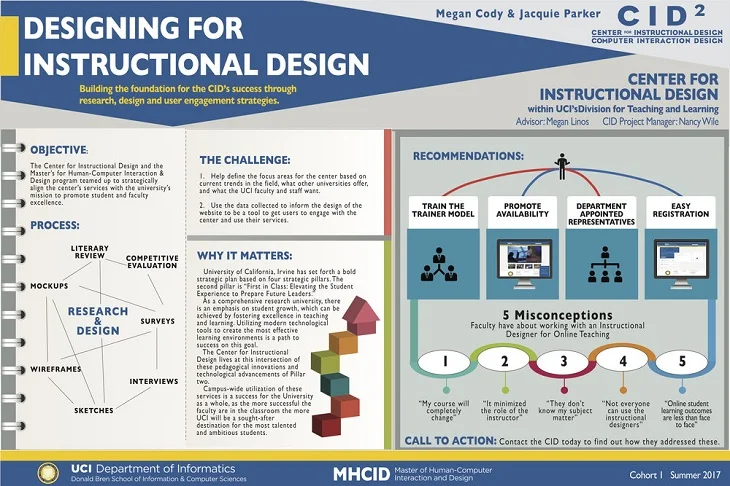Designing for Instructional Design
Course:
Capstone
Date:
2017
Skills:
Heuristic Evaluation, Competitive Analysis, Sketching, Wireframe, Mockup, Interviewing, Discussion Guide Creation, Survey Creation
Team:
CID2: Megan Cody, Jacquie Parker
The Proposed Solution
Over the course of the capstone project, team CID2 implemented user-centered design principles to address the multifaceted challenge. First, help define the focus areas for the center based on current trends in the field, what other universities offer, and what the UCI faculty and staff want. Then use this data to inform the design of the website to be a tool to get users to engage with the center and use their services.
The Problem
The Center for Instructional Design wants to establish their presence, increase usage, and promote faculty engagement with each other through the establishment of the center as a “hub” for teaching innovation and learning collaboration. In an order to be the thought leaders on campus and to provide services that bridge together the resources and the experts, the new leadership of the Center for Instructional Design called on the partnership with MHCID to better understand how to reach and engage their stakeholders.
The Process
Team CID2 utilized both external and internal research initially to have a better understanding of the field of instructional design, which is the practice of creating educational experiences for students which make the acquisition of knowledge and skill more efficient, effective, and appealing. We then used a competitive evaluation, interviews and survey methods to define what was specifically needed by the UCI faculty and what would align with the culture and mission of the UCI. The double diamond method helped us design for the underlying best practices for implementation of these key areas of focus we found from our research.
The Outcome
Through research, we identified that the two main areas of focus for the website would be Contact Us and Events. We provided a mockup deliverable that made these two areas an effective and efficient call to action for visitors of the site. This allows the CID team to interact with people simply by spreading awareness of the CID staff’s availability and willingness to be of assistance, and by promoting the expertise of the staff through the events they put on. Finally, we provided strategic recommendations on methods to engage their users, including a train-the-trainer model for representatives from the different academic departments across the campus, and providing short How-tos or compelling fact sheets in an easily digestible format to catch their attention and to establish trust that the CID is an expert in their field.
Document
See the full documentation here.
